NORTH WALES COAST RAILWAY:NOTICE BOARD
Rheilffordd arfordir gogledd Cymru: Hysbysfwrdd
04 January 2019
Share on Twitter
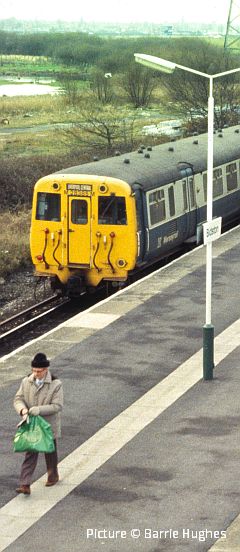
Tweets by @NWrail1
Contributions and comments are encouraged: see the Contributions Page
February 2019
Tuesday 5 February North Wales Railway Circle NWRC Secretary Peter Hanahoe will give 'A 1980s Extravaganza' slide-show.
Friday 8 February Altrincham Electric Railway Society Steam and Diesel in the Northern Fells 2010-2016. A digital presentation by Ian Pilkington.
Wednesday 6 February RCTS Liverpool "North West & North Wales Reminiscences of the 1960s" John Cashen
Monday 18 February RCTS Chester "A Taste of Japan" Gordon Davies
March 2019
Friday 1 March Clwyd Railway Circle “Annual General Meeting” followed by “Chairman’s Choice” A night of self indulgence from the retiring chairman, David Jones
Tuesday 5 March North Wales Railway Circle 'Next Train's Gone!'..Humph Davies with an illustrated historical survey of the route of the North Wales Narrow Gauge Railway & Successors, Part 1. Caernarfon -Rhyd Ddu.
Friday 8 March Altrincham Electric Railway Society. The Glorious Steam Railways of India. Steam across India from 1976 to the early 1980s. A digital presentation by John Sloane.
Monday 18 March RCTS Chester "55 Years of Railway Photography, Part 2" Les Nixon
April 2019
Tuesday 2 April North Wales Railway Circle Gareth Haulfryn Williams, archivist and author, on 'Rails to/from Bethesda.'
Wednesday 3 April RCTS Liverpool "Manchester to Liverpool by CLC" Ken Grainger
Friday 5 April Clwyd Railway Circle "Scotland in the 1960s" The talk covers the whole of Scotland - going up the west side to Wick and Thurso and returning down the east side from/to Carlisle.
John Cashen
Friday 12 April Altrincham Electric Railway Society Great Western and Southern Steam in the West Country. A colour slide presentation by Alf Storey.
Monday 15 April RCTS Chester "Steam on the North Wales Coast" (Video Presentation) Ron Watson Jones
May 2019
Tuesday 7 May North Wales Railway Circle AGM and Members' Photo. Competition.
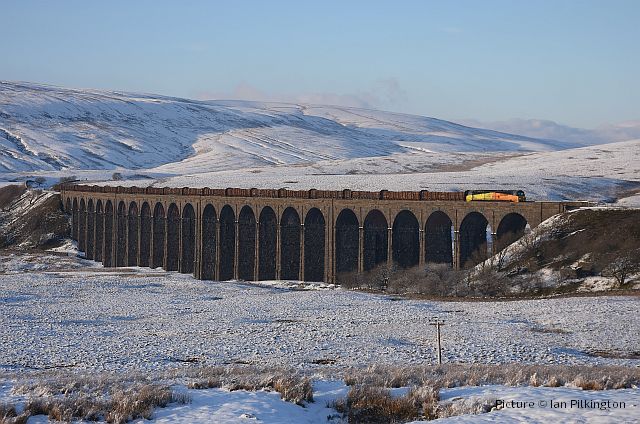
70 801 heads train 6J37, Carlisle - Chirk logs over Ribblehead Viaduct on Thursday 31 January (Ian Pilkington).
Red to silver revisited
We have some more information about the problems at Newton-le-Willows on 22 January (last issue) giving some insight into how 'Control' deal with such incidents, using their authority to use an available loco to clear the main line.67 020's engine shut down and would not restart. Assistance was summoned in the in the form of the loco working the 10:28 0F35 light-engine from Warrington Arpley to Seaforth Container Terminal. This loco 'dragged' the stricken passenger train to Warrington Bank Quay, where 67 020 was uncoupled and hauled by the 0F35 loco on to Arpley sidings pending a move to Toton for attention.
67 014 was dispatched from Crewe electric depot and returned the empty coaches from Warrington to Crewe Carriage sidings via Manchester Piccadilly. The 14:07 intermodal freight from Seaforth to Glasgow Mossend left two hours late, but made up some of the time on the journey.
Peter Basterfield's view
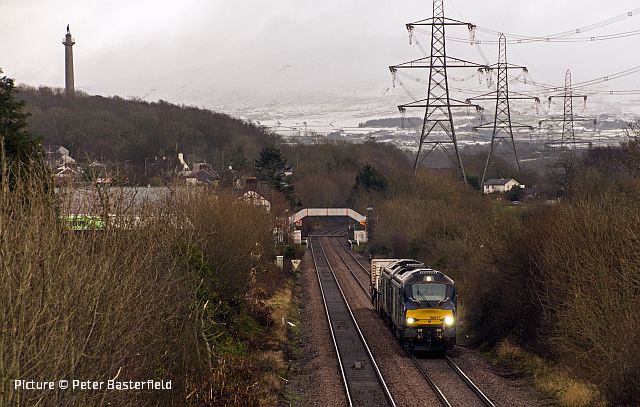
Snow lies on the mountains on 23 January as 68 017 Hornet and 68 018 Fearless pass Llanfair PG with the westbound flasks. The Marquess of Anglesey's column on the skyline closed in 2012 due to safety issues with the stairs; it appears there is now a Heritage Lottery grant of £60K towards renewal and re-opening ...
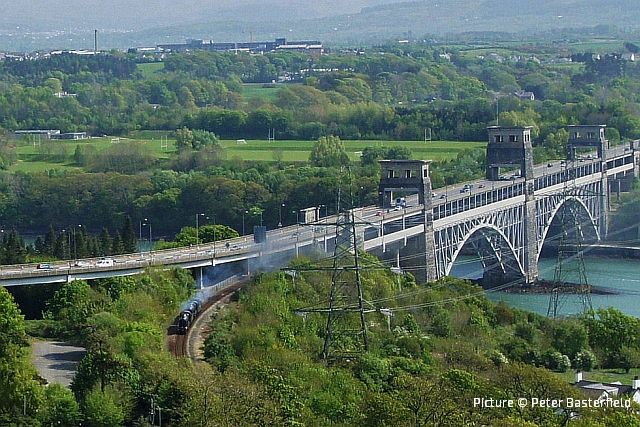
... which will enable pictures like this one to be taken again. Ex-GWR Locos 4965 and 5043 cross the Britannia Bridge with a charter.
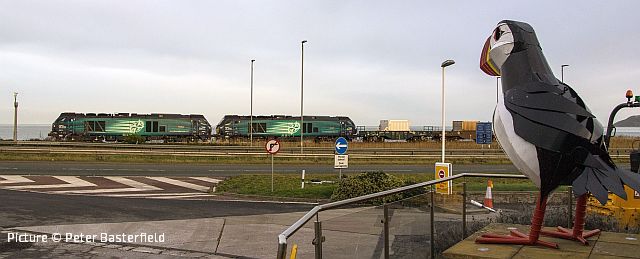
'Two Cats and a Puffin' - 68 016 and 68 017 pass the Puffin Café alongside the A55 near Penmaenmawr on 21 January. [Class 68s are thought by some enthusiasts to have feline facial characteristics.]
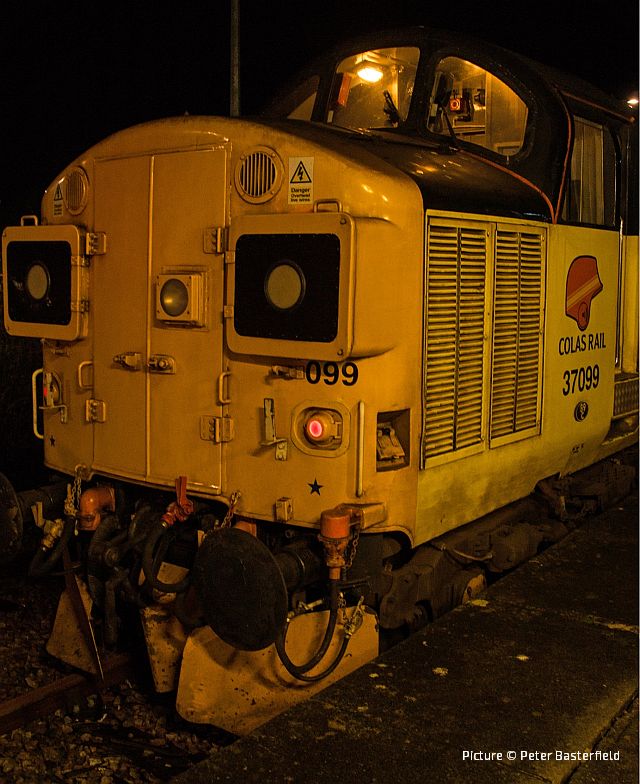
Vintage loco 37 099 stands in the bay platform at Bangor on 29 January, having arrived with a Network Rail measurement train from Crewe.
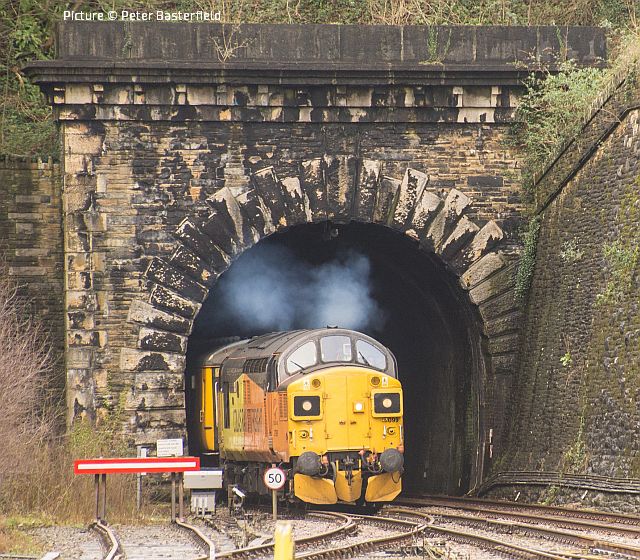
The following day, the train drew forward into Belmont Tunnel (driving trailer 9714 leading) to return over the crossover to Platform 1 and departure back to Crewe.
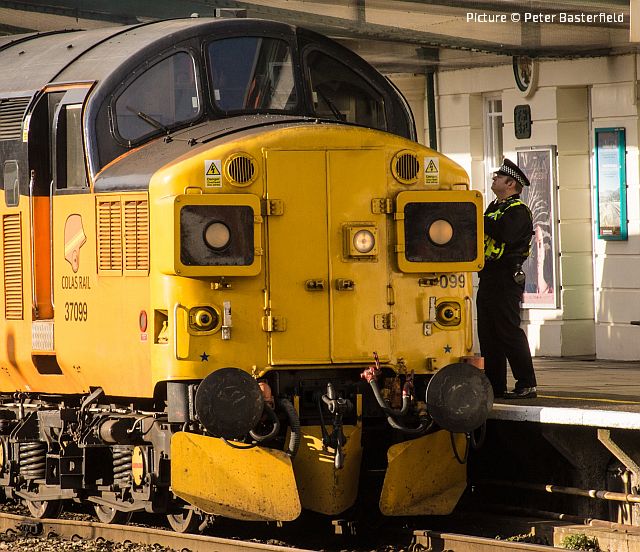
'Is this your vehicle, sir?'
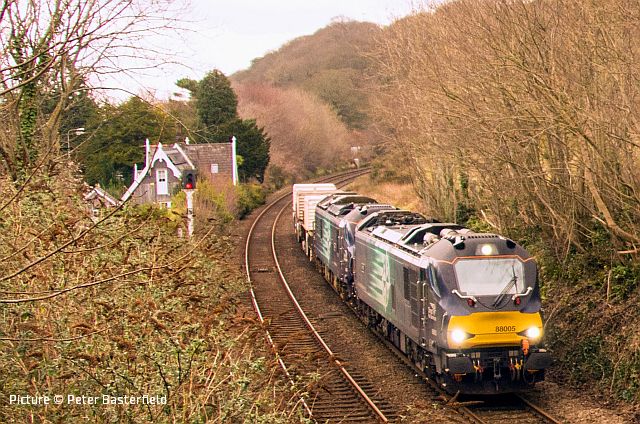
On 1 January, 6D43 Valley - Crewe flaks with 88 005 Minerva and 88 003 Genesis at Belmont Road Bridge.
More Colas
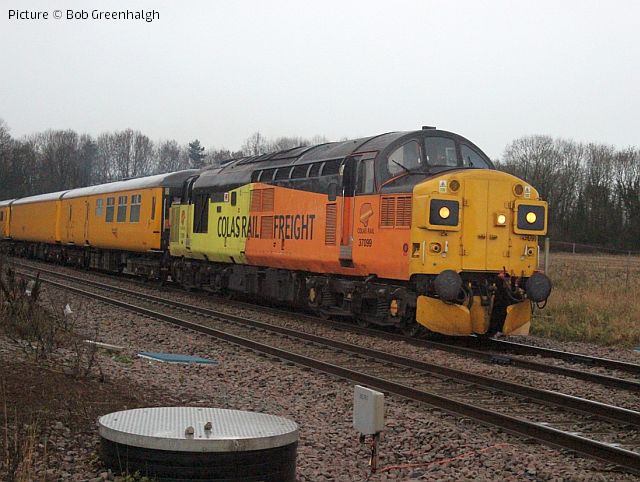
37 099 was on its way from Crewe to Bangor (via Shrewsbury and Chester) when captured by Bob Greenhalgh passing Balderton Crossing on 29 January.
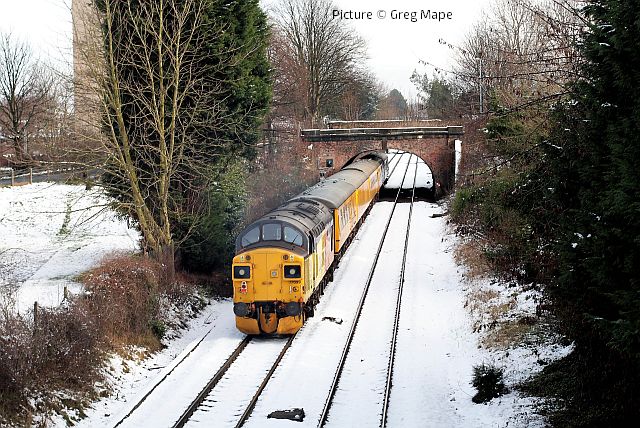
31 January saw 37 099 on a further itinerary from Crewe via Middlewich and Altrincham to Stockport and back, then on to Derby. Greg Mape photographed it at Baguley on the way to Stockport with the driving trailer leading ...
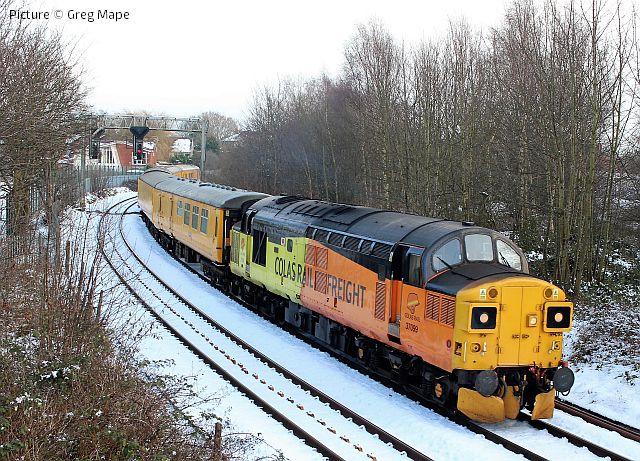
... and the return trip on the sharp curve between Skelton and Deansgate Junctions ...
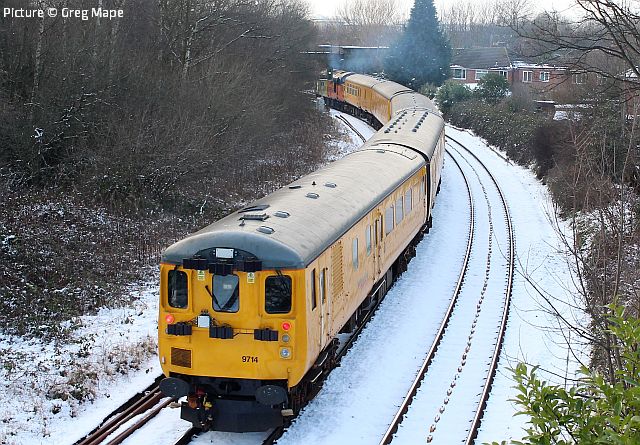
... with 9714 on the rear. Note the 'anchors' between the rails to help prevent any tendency to sideways movement of the track.
Courtaulds shunters
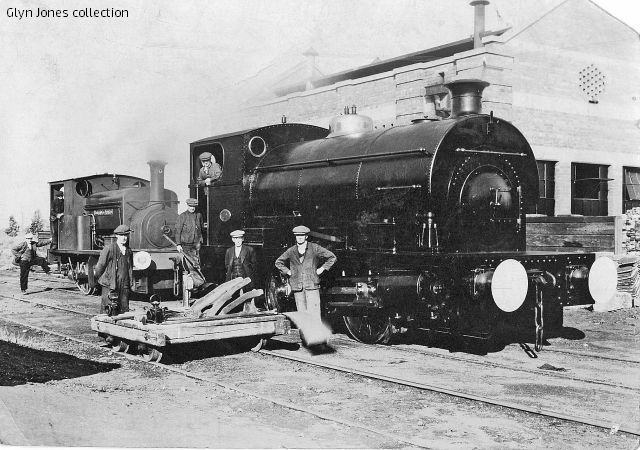
Glyn Jones sends this photograph which has been passed to him, with written on the back 'an Courtaulds Castle Works Flint shunter' and the date 20 October 1939. Referring to the Industrial Railway Society's book Industrial Locomotives of North Wales we suggest the loco in the foreground is a Peckett-built 0-4-0ST, probably works no. 1810 of 1930. The other 0-4-0ST has the look of a Manning, Wardle product, works no. 1984 of 1919, which was taken over from the contractors who built the works in 1919-20, and was given a nameplate 'Courtaulds Limited' which can be seen on the tank side.
Castle works, one of a number of Courtauld installations in the area, was engaged in the production of 'artificial silk' (trade name Rayon). It was built on the site of a former alkali works, alongside the North Wales main line west of Flint station. It closed in 1977 and was demolished in 1980, replaced by new industrial units.
Helsby Freight Memories - by Chris Jones-Bridger
The 1980 shots from Helsby tell a story and prompt memories from a time that I have very little photographic record of my own, being reliant on what was published in contemporary magazines and books.
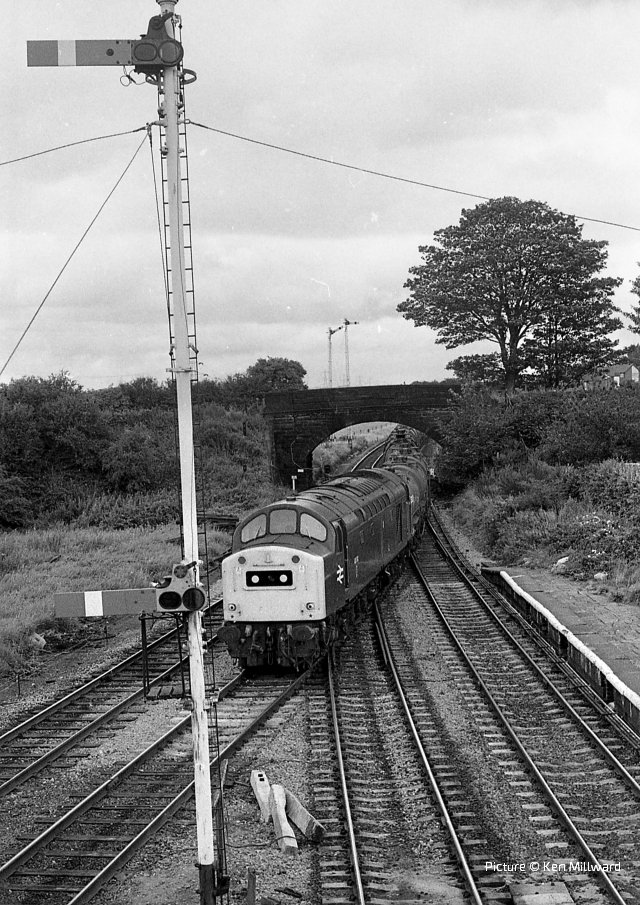
Ken Millward's picture in the last issue of 40 174 with caustic soda tanks taking the Hooton line (repeated above) shows trip working 6T56 from Runcorn Folly Lane to Ellesmere Port. On arrival the tanks were exchanged to the Manchester Ship Canal network to be tripped to their intimate destination of Unitank at Eastham. Trip 56 used one of the Liverpool Division trip locos under the direction of the Area Manger Northwich - in practice, directed by the Northwich based shift Traffic Manager located in the TOPS office in the station building at Northwich.
Crewed by Northwich train crew, Target 56 - as it was known - had a roving brief in the morning and evening to move the caustic soda traffic from Runcorn to either Ellesmere Port for Unitank or Wallerscote, later Oakleigh sidings for ICI. While a weekly loading programme was produced the daily challenge was to produce a productive plan for Target 56 to ensure the loco & crew were efficiently utilised as delays to discharge and loading were a constant factor affecting the the availability of the tanks at the different exchange sidings.
Rather than the backwater it has become, the Helsby to Hooton line was exceptionally busy with freight and still supported a passenger service from to Rock Ferry. While only involved in relatively short distance trips, T56 crews could encounter many delays. In jest the some crews would refer to the Rock Ferry DMU as the 'Royal Train' as everything else had to stop for it!
During the afternoon T56 was planned for an out-and-back trip from Northwich to Dee Marsh. While its primary traffic flows fed Shotton steelworks, and during the early 80s cleared vast amounts of scrap for Sheffield and Scunthorpe as the works was dismantled after closure. An occasional flow was tanks for the Synthite works at Mold; from Dee Marsh these fed into Croes Newydd before the final delivery on the weekly Mold trip.
How times have changed regarding ballast trains. Before the days of 'virtual quarries' with their bulk ballast deliveries, civil engineers' ballast hoppers were returned to the supplying quarry for reloading. This resulted in several services a day feeding into Penmaenmawr. From the Liverpool Division there were several planned services from civil engineers sidings such as Edge Hill, St Helens, Warrington Dallam and Helsby. In practice after weekend engineering work the empty hopper sets could be dispersed around a wider range of stabling locations dependant on the location of that weekend's engineering possessions.
Many a time the St Helens to Penmaenmawr would start from Northwich with the booked Garston or Wigan Springs Branch crew and loco being dispatched light loco to work.
Trainload flows that seemed so permanent at the time are now but history and the management of ballast trains, infrastructure trains as we must now call them, has undergone nothing short of a revolution, and Penmaenmawr granite is no longer used.
Looking back: December 1982 - with Barrie Hughes
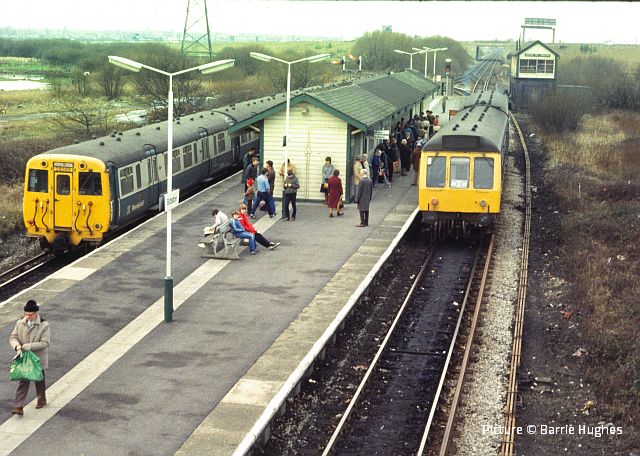
Three pictures from 30 December 1982. Above, trains at Bidston station, still the interchange point between the Borderlands and MerseyRail. Passengers are transferring between the hourly Wrexham DMU and the MerseyRail services. Unit M28385M is heading west towards West Kirby whilst the DMU will return to Wrexham Central after a short layover.
Bidston Dee Junction signal box controlled the junction just to the west of the station; the Wrexham line can be seen curving to the south. The EMU is already signalled for West Kirby and also has the return destination Liverpool Central on the rear. The M53 motorway, opened in 1972, crosses the West Kirby line in the distance. The DMU's front window has a placard showing the 'link line' symbol. Wrexham-Birkenhead trains had been cut back successively from Birkenhead Park to Birkenhead North and by this date to Bidston, a rather windswept unwelcoming station on the marshes with minimal facilities. . DMUs were extended to New Brighton for a while at weekends and Bank Holidays for tourist traffic.
In the 70s when I first travelled the route DMUs terminated at Birkenhead Park where there were two island platforms. By 1970 the two central roads were cut off at the east end by a walkway effectively creating central bays were the DMUs terminated with electric services using the outer edges of the two islands. More recently only the former westbound island is in use. Later services were terminated at Birkenhead North for a few years where there is an island platform as well as an edge platform, allowing cross-platform interchange.
The Class 503 EMUs were introduced in 1938 and were supplanted by Class 507 and Class 508 EMUs. The Class 508s were initially diverted to services out of London Waterloo and did not arrive on the Wirral Line services until June 1984, finally displacing the Class 503s by the end of March 1985. All but one set of Class 503 were withdrawn and scrapped by 1985. The final set was used on special Merseyrail services until 1988, repainted in LMS maroon livery. The preserved set was kept at the Electric Railway Museum near Coventry until it closed last year. The unit has been moved moved to the Locomotive Storage Ltd warehouse, the former Hornby works, at Margate.
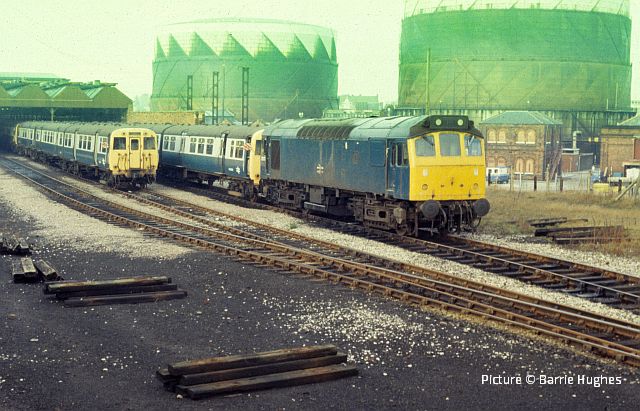
25 117 with stored Class 503 EMUs, including M29373M, at Birkenhead Mollington Street. The depot was closed on 25/11/85 and demolished in July 1987; the site is still vacant. The loco lasted two more years, being withdrawn on 22/1/84 and cut up at BREL Swindon on 2/6/84.
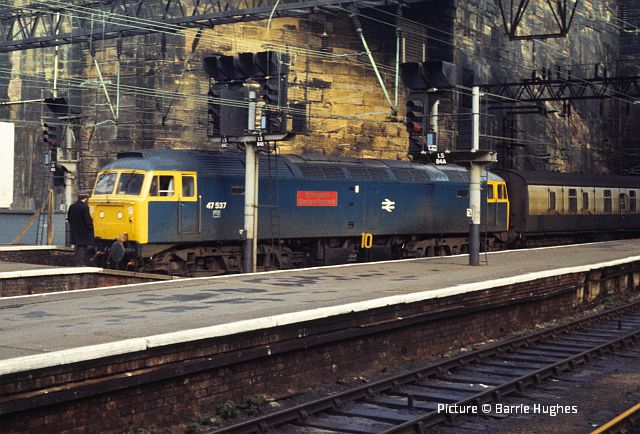
47 537 Sir Gwynedd/County of Gwynedd, with its huge bilingual nameplate, arriving at Liverpool Lime Street. Crewe Diesel Depot often provided this loco on North Wales coast trains. A BR driver, complete with the BR greatcoat and cap, stands waiting at the end of the platform for the 'turnover' loco to shunt on to the other end of the rake. Wearing of the BR cap fell out of fashion a few years later!
Originally 47 073, this loco was renumbered when electric train heating equipment was fitted in August 1974. The bilingual nameplate policy began in the 1980s producing these huge nameplates, many of which were applied to Class 37s as well. This loco was named at Holyhead station by Councillor William George, Chairman of Gwynedd Council, on 1/11/82 so had only carried the name for a couple of months when this image was captured. The nameplates were removed in 22/12/93. The loco is still in service today as 47 772, as renumbered in January 1994, with West Coast Rail, Carnforth, in their drab maroon livery.
Crewe locos - pictured by Martin Evans
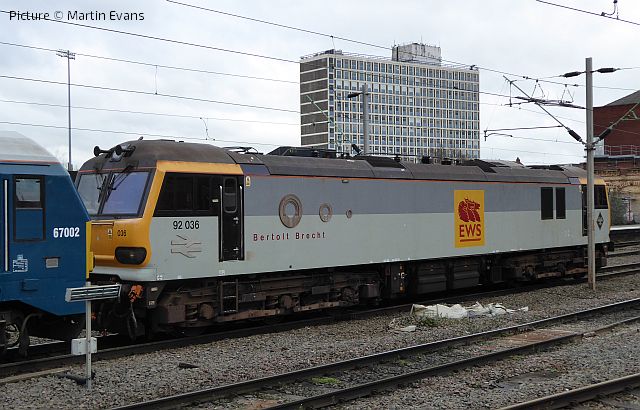
A brief visit to Crewe on 25 January found two locos waiting for the road after coming off the Electric Depot. 92 036 makes a nostalgic sight, as it still carries full 'Channel Tunnel' livery with cast metal adornments, and painted name Bertolt Brecht. Several of these locos - the only locos allowed through the tunnel - have been dispatched to railways in to eastern Europe. Is there no hope for an increase in international rail freight to and from Britain?
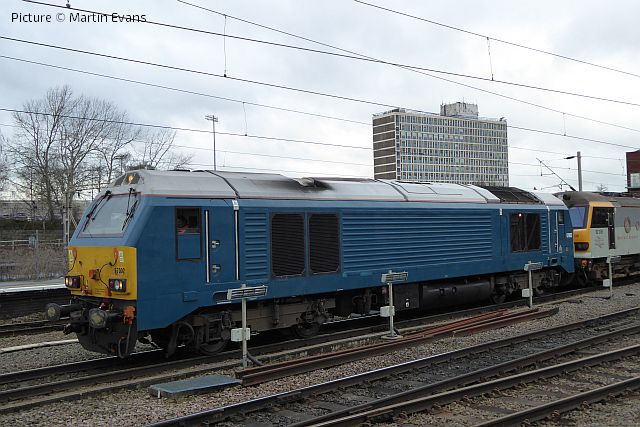
In harness, Arriva blue loco 67 002, another rare sighting.
Cambrian Corner: 31s in 1992 - with Barrie Hughes
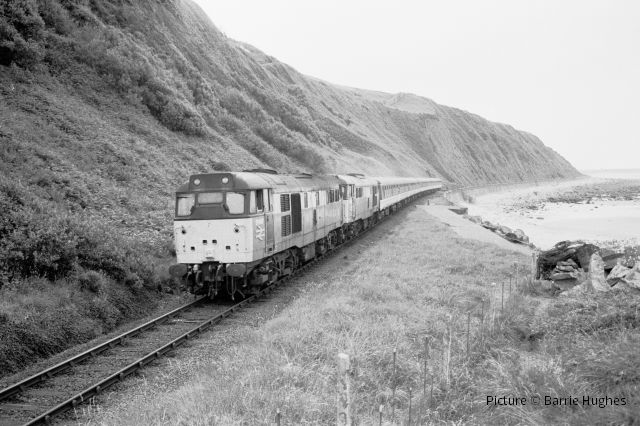
Here are some black and white negative scans of the Cambrian Coast in the 90s dated 30 May 1992. The Summer-dated Butlin's specials were hauled by Class 37s for some years, but in the final years Class 31s were used sometimes. Above, ' Dutch'-liveried 31 146 and 31 147 double-head the Butlins Pwllheli train from London northbound approaching Harlech, coming off the sea wall section with the popular footpath crossing visible.
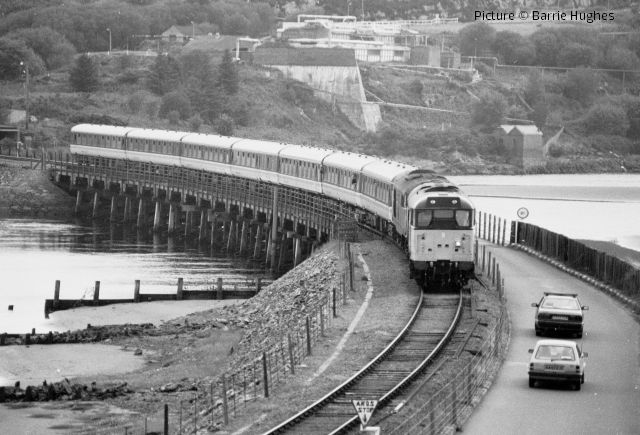
The 31s return from Pen-y-chain with campers returning home to the Midlands, crossing Pont Briwet and approaching Llandecwyn Halt. ICI’s Cooke’s explosives factory Penrhyndeudraeth is visible in the background.
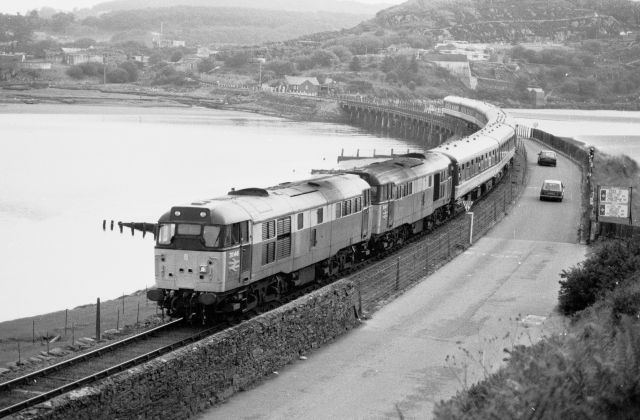
A14 The 31s in close up. Pont Briwet as viewed from Y Garth, a view no longer available since the hill has been fenced off. The original wooden viaduct Pont Briwet was opened 10/10/1867 and replaced by a concrete structure which opened on 1/9/2014 after a year’s closure to trains.
31 146 was named Brush Veteran a few months later on 27/8/92, withdrawn on 24/3/00 and cut up 1/7/2004 at Booth-Roe Metals, Rotherham. 31 147 was named Floreat Salopia a year later on 31/5/93 and de-named 31/5/97. It was cut up in April 2001 at Harry Needle Railroad Company at Barrow Hill.
Postscript: The Butlin's Railway
The route of Butlin's narrow gauge railway and coastal balloon loop/terminus at Pwllheli camp is still visible in Google Earth. The railway operated for 43 years from 1953 to 1996. A YouTube video shows ‘Tri-ang’ style American outline ‘steam’ loco No.157 CP Huntington in action. The Tri-ang model was available from 1962-1967. Similarly named locos operated at other Butlins camps deriving from the popular 'Casey Jones' TV series (USA 1958). Although shown on BBC in the sixties, I have a feeling the series was originally shown in the UK around 1959 on ITV after its USA premiere in 1958.
North Wales Coast home page | Archive | Previous Notice Board